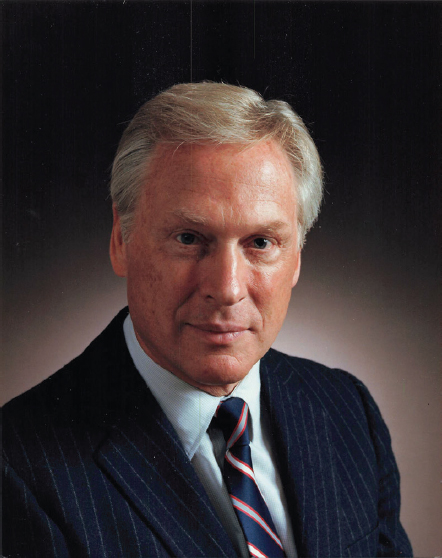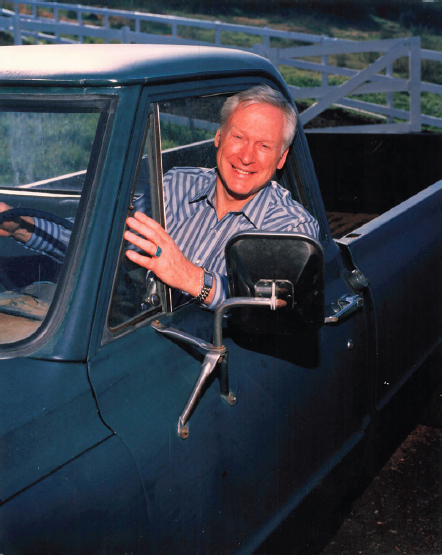MALCOLM R. CURRIE
1927–2021
Elected in 1971
“Major innovations in electron devices and contributions to large systems in research and development.”
BY YANNIS C. YORTSOS AND C.L. MAX NIKIAS
MALCOLM RODERICK CURRIE, engineering physicist and former chair and CEO of Hughes Aircraft Co., died April 18, 2021, at the age of 94. A defense and aerospace industry giant, he was best known for his work at the helm of Hughes Aircraft in the wake of the defense contractor’s acquisition by General Motors. His distinguished career in electronics and weapons research and development included public service as undersecretary of defense research and engineering in the US Department of Defense. He also served as national armaments director. He was elected to the NAE in 1971.
Currie was born March 13, 1927, in Spokane, Washington, to Genevieve (née Hauenstein) and Erwin Caster Currie. He enlisted in the Navy during World War II, but the war ended before he could complete flight training. He took a discharge to earn his bachelor’s degree in physics and doctoral degree in engineering physics from the University of California, Berkeley.
He began his career as a research scientist at Hughes Aircraft Research Laboratories in 1954, and quickly rose to director of
__________________
The authors gratefully acknowledge the assistance of Barbara Currie in preparing this tribute. The text also includes material from the USC announcement “Aerospace industry pioneer and USC Trustee Malcolm Currie, 94” by USC writers Gustavo Solis and Lynn Lipinski.
the company’s research and development engineering division. There, he led projects such as the first digital airborne radars, laser systems, parameter amplifiers, electric propulsion, early satellite communications electronics, and ion beam semiconductor implantation. He authored or coauthored numerous technical papers and patents. Many in the scientific and aerospace communities took note of his achievements. Among them was renowned scientific instrument inventor Arnold Beckman (NAE 1967), who recruited Currie to head research and development for his company, Beckman Instruments, a biomedical product developer and manufacturer. Currie was vice president for product development and was involved in the first commercial DNA sequencer, peptide synthesizers, and other scientific instruments.
His abilities and accomplishments soon earned him another honor, this one from the federal government. In 1973, two years after joining Beckman, Currie was appointed undersecretary of defense research and engineering, responsible for planning, managing, and guiding the Defense Department’s weapons research, development, and acquisition programs. In his concurrent role as national armaments director for NATO, he started and guided pioneering programs on the global positioning system and cruise missiles. He spearheaded many systems, from stealth aircraft and cruise missiles to turbine-powered M1 tanks, the Global Positioning System for satellite navigation, night vision, and smart weapons. He also chaired the DOD’s Intelligence Research and Development Council.
Four years later, he returned to Hughes and steadily rose through its ranks to become chair and CEO in 1988. He led the company for 5 years until his mandatory retirement at age 65 in 1993. He is credited with leading its strategic diversification from defense into such areas as commercial satellite communications and private business network products. He also pioneered early research in traveling-wave tubes, lasers, millimeter waves, electric propulsion, and applications of electron and ion beams.
Currie served on the University of Southern California’s Board of Trustees since 1989 and as chair from 1995 to 2000,
overseeing a period of growth and success that included the near-doubling of the university’s endowment and its selection by the Time/Princeton Review College Guide as College of the Year in 2000. In honor of his service, he received the university’s highest honor, the Presidential Medallion, in 2001. He also served, until his death, on the USC Viterbi School of Engineering Board of Councilors.
In recognition of their investment in USC’s biomedical research and education, a new Health Sciences Campus residence hall that opened in 2016 was named the Malcolm and Barbara Currie Residence Hall. Their generosity to USC also includes the 2008 endowment of the Malcolm R. Currie Chair in Technology and the Humanities, USC’s first endowed faculty position honoring exceptional achievements in both realms. In an interview at the time, Currie said that he and Barbara wanted to “recognize that many of our most effective leaders of the future will have a depth of understanding of the technologies that are changing our world as well as the breadth of vision and perspective that come from study and love of the humanities.”
In service beyond USC, he was president (1994) of the American Institute of Aeronautics and Astronautics and a fellow of the Institute of Electrical and Electronics Engineers (IEEE). For the National Academies of Sciences, Engineering, and Medicine, he served on the Naval Studies Board’s Advisory Council for the Study on Technology for Future Naval Forces (1996–97) and the Government-University-Industry Research Roundtable (1992–94).
His many honors included Distinguished Service Medals in national and foreign intelligence and from both DOD and NASA, all in 1977, as well as the 1993 Goddard Astronautics Award and 1995 IEEE Founder’s Medal, 1993 Goddard Astronautics Award, and 1995 IEEE Founder’s Medal. In 1992 the US Air Force Academy presented him with the Thomas D. White National Defense Award for outstanding contributions to the national defense and security of the United States. He held the rank of commander in the French Legion of Honor and was inducted into the Space Technology Hall of Fame in 1998 for his work on the global positioning system.
Mal Currie was a remarkable engineer and innovator with a very entrepreneurial spirit. He held many patents and published numerous papers on topics from lasers to space propulsion. Not one to rest in retirement, he founded Currie Technologies, a developer and distributor of electric bikes and scooters, demonstrating his confidence in what he told The Wall Street Journal in 2000 was “the coming electric revolution.” He and Barbara shared a love of rare horse breeds. For 3 decades they studied horse breeding history and bloodlines and visited farms around the world to import, breed, and raise Pure Spanish Horses (Andalusians) on their ranch in Agoura Hills, California. They also enjoyed USC football and regularly attended games, cheering the Trojans.
Barbara reminisced about Mal and contributed the following:
While at the Hughes Research Labs, he shared an office with Murray Gell-Mann, a physicist who later won the Nobel Prize (1969) for work on theory of elementary particles. Dr. Gell-Mann spoke 13 languages fluently and was a student of Southwestern US archaeology in his spare time. Mal didn’t learn any more languages from Dr. Gell-Mann, but started the lifelong habit of surrounding himself with the most brilliant people he could find.
He trusted his instincts about technology and in that respect gambled. He trusted the science when he was at Hughes and won for the company the multibillion-dollar contract for the AMRAAM missile, having spent untold millions on the development. As chairman of Hughes, he supported the expense and many-year corporate deficit of the commercial satellite program that became DirecTV.
While under secretary of defense, he convinced the Army to put the 105MM cannon on the M1 Abrams Main Battle Tank and to change from diesel engines to the gas turbine engine, eliminating the tell-tale trail of exhaust. Also, as DDR&E, he called all the services together, discontinued all their programs for the precursor of the GPS and assigned DARPA and the Air Force to develop the military version. The military version
was opened to the public (modified to only an accuracy of 100 meters) by President Reagan, and the fully accurate version was released by President Clinton.
He trained as a Navy pilot (bi-wing Stearman) and often wondered what his life would have been if he had continued in the Marine Corps (he had the option after completing Navy basic training to select Navy or Marines). Because of his love of flying, as DDR&E one of his great joys was flying (second pilot) in the B-1, the B-2 Stealth bomber, the Harrier, and the Swedish Viggen, among others. He also tested the German Leopard tank on their test course in Germany—and was embarrassed to have taken a sharp turn and knocked down a tree. The general who was his escort assured him that he did a fine job, as a French general had done much more damage the week before.
General Motors had just bought Hughes and Mal was involved with the SunRaycer program. Paul MacCready (NAE 1979) designed it and GM built it, as a precursor to all the modern electric and hybrid vehicles, and probably feeding into Mal’s forever love of hybrid power. It raced across Australia (from Darwin to Adelaide, 1950 miles) and there was a whole caravan of “helpers,” scientists, repair people, etc. Each night they camped along the way, sleeping in tents that they pitched themselves. In looking at pictures, we all giggled, because even though Mal had done all sorts of outdoor things with his family, his tent was always the one (and only one) that was somewhat tilted. Mal was thrilled with the battery technology and was a happy participant in the team that went ahead of the SunRaycer actually sweeping the surface of the road to get rocks out of the way. The GM SunRaycer won the race a full 2½ days ahead of the second entrant, Ford. I think the SunRaycer is now at the Smithsonian. 1
Important to the DOD was the House Appropriations Committee, and particularly its chairman, George Mahon (D-TX), who also headed the Defense Subcommittee. Whenever the chairman would call, he, of course, was greeted
___________________
1 It is in the Smithsonian’s National Museum of American History (https://americanhistory.si.edu/race-cars/gm-sunraycer-1987).
by “Yes, Mr. Chairman, if I possibly can, Mr. Chairman,…” One day, Chairman Mahon called and asked Mal to meet with two men from his district who had a machine that could revolutionize weaponry, and, possibly, the world, and they, being great Americans, wanted to offer it first to DOD. Mal set up a time that day to see the men. They arrived with a small suitcase in hand and proceeded to tell Mal about the wonderful machine in the suitcase that solved the problem of generating electricity—it was a perpetual motion machine. Mal asked how this might relate to the laws of thermodynamics, drew blank stares from the men, and they said “let us give you an example.” They started to open the machine to plug it in and Mal said, “Wait…do you have a patent on this?” No. “You must get one before you show this even to me, because you know that someone in the government will try to steal this great invention of yours and leave you without any ownership at all.” So, alas, another perpetual motion machine lost, but Chairman Mahon was pleased, so the world continued.
Mal is survived by his wife of 44 years, Barbara (née Dyer); children Deborah Currie, David Currie, and Diana Currie-Hull, from his marriage to the former Sunya Lofsky; and two grandchildren.










